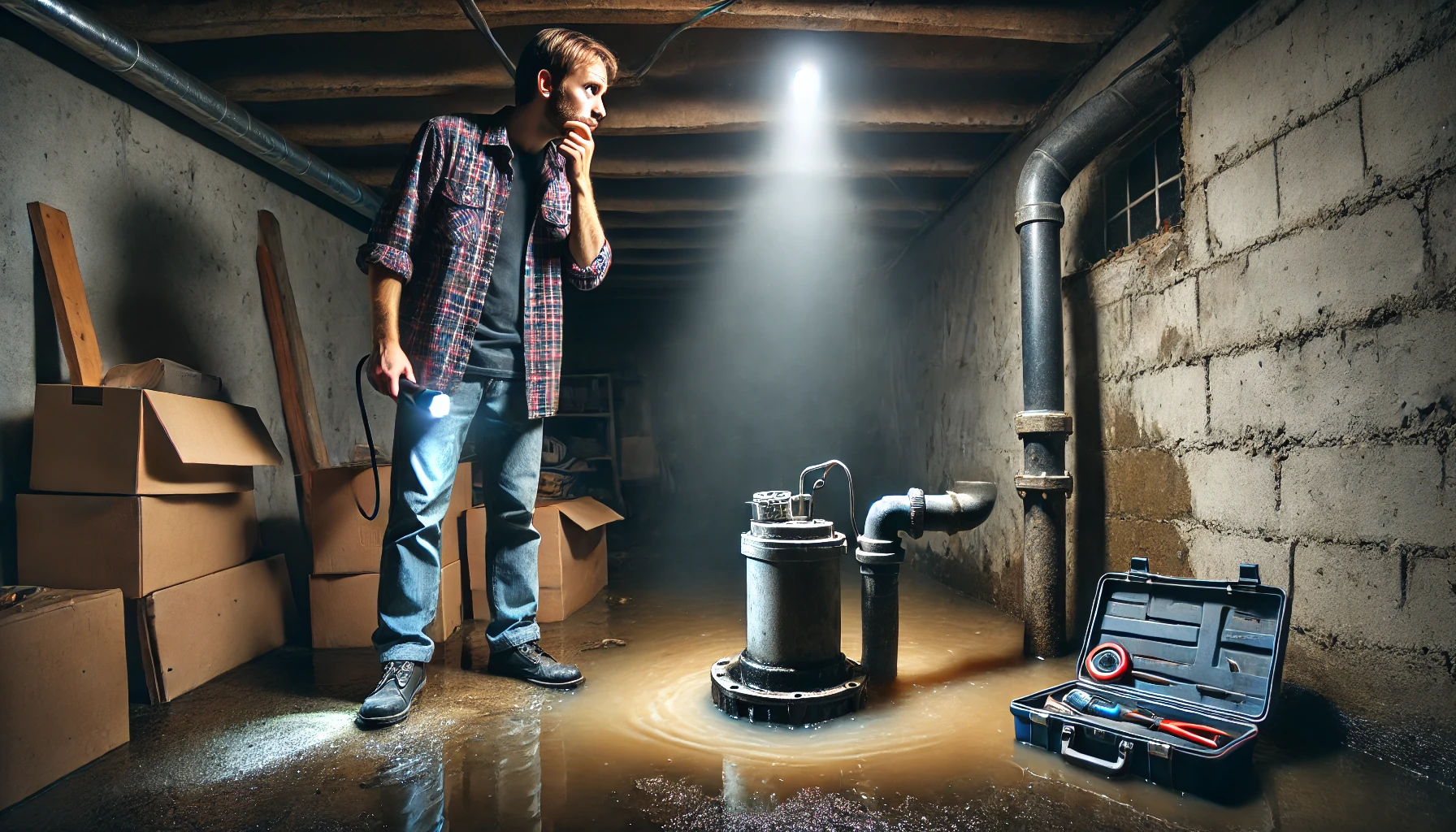When your sump pump stops working, it’s more than just an inconvenience – it’s a potential disaster waiting to happen. As a homeowner, understanding how to troubleshoot and maintain your sump pump is crucial for protecting your property from water damage. Let’s dive into the world of sump pumps and explore how to keep yours running smoothly.
Understanding Your Sump Pump System
Before we tackle troubleshooting, it’s essential to understand the basics. A sump pump is your home’s first line of defense against basement flooding. It’s typically installed in the lowest part of your basement or crawlspace, in a pit called the sump pit. When water levels rise, the pump activates, removing excess water and directing it away from your home’s foundation.
Common Reasons for Sump Pump Failure
- Power Issues: Often, the simplest explanation is the correct one. A tripped circuit breaker or unplugged cord can render your pump useless.
- Float Switch Problems: The float switch tells your pump when to turn on and off. If it’s stuck or malfunctioning, your pump won’t operate correctly.
- Clogs and Debris: Your sump pit can accumulate debris over time, potentially clogging the pump or impeller.
- Overheating: Like any motor, sump pumps can overheat if they work too hard or too long.
- Improper Installation: A poorly installed pump may not function efficiently or could fail prematurely.
Why Does My Sump Pump Keep Running?
A constantly running sump pump can be concerning and may indicate an underlying issue. Here are some common reasons why your sump pump might be running continuously:
- Excessive water inflow: If your area is experiencing heavy rainfall or snowmelt, or if there’s a high water table, your pump may need to run frequently to keep up with the water influx. This is normal during wet seasons but could indicate drainage issues around your home if it persists.
- Float switch problems: The float switch signals the pump to turn on and off. If it’s stuck in the “on” position or improperly adjusted, it will cause the pump to run continuously. Check if the float can move freely and isn’t obstructed by debris or the sides of the sump pit.
- Check valve failure: A faulty check valve can allow water to flow back into the sump pit after being pumped out, creating a cycle where the pump runs constantly. Inspect the check valve to ensure it’s working properly and not allowing backflow.
- Incorrect pump size: If your pump is too small for your home’s water intake, it may run constantly trying to keep up. Conversely, an oversized pump may short-cycle, turning on and off frequently.
- Clogged or frozen discharge pipe: If the discharge pipe is blocked or frozen, water can’t be expelled properly, causing the pump to run continuously. Ensure the pipe is clear and properly sloped away from your home.
- High water table or underground springs: Some locations naturally have high water tables or underground springs that can cause constant water inflow, requiring the pump to run frequently.
- Malfunctioning pump switch: If the pump’s internal switch is faulty, it may not shut off when it should.
- Leaky check valve or discharge pipe: Leaks can cause water to return to the pit, creating a continuous pumping cycle.
- Power surges: In some cases, power surges can cause the pump to malfunction and run continuously.
- End of pump life: As pumps age, they may begin to malfunction, potentially leading to continuous operation.
If you’re unable to identify or resolve the issue, it’s best to consult with a professional plumber or sump pump specialist. They can diagnose the problem accurately and recommend the appropriate solution, whether it’s a repair or replacement of your sump pump system.
Remember, a continuously running pump can lead to premature wear and increased energy costs, so it’s important to address the issue promptly to ensure your home remains protected from potential water damage.
Troubleshooting Steps
Let’s roll up our sleeves and get to work. Here’s how to diagnose and potentially fix your sump pump issues:
- Check the Power Supply First things first – ensure your pump is plugged in and the circuit breaker hasn’t tripped. It sounds obvious, but you’d be surprised how often this is the culprit. Test the outlet with another device to confirm it’s working.
- Inspect the Float Switch The float switch is crucial for automatic operation. Try manually lifting the float to see if the pump activates. If it doesn’t, the switch may be faulty or obstructed. Clear any debris that might be interfering with its movement.
- Look for Clogs Unplug the pump and remove it from the pit. Check the intake screen and impeller for any debris. Don’t forget to inspect the discharge pipe for clogs as well. A garden hose can be handy for clearing minor blockages.
- Address Overheating Issues Ensure your pump is properly submerged. If the pit is too small or too large, it can cause the pump to cycle on and off frequently, leading to overheating. Consider upgrading to a pump with thermal protection if this is a recurring issue.
- Verify Proper Installation Check that the check valve is installed correctly (arrow pointing away from the pump) and that the discharge line is positioned to direct water away from your home’s foundation.
How to reset sump pump
Resetting a sump pump is often a straightforward process, but it’s important to note that not all sump pumps have a dedicated reset button. Here’s a step-by-step guide on how to reset your sump pump:
- Safety first: Before attempting any reset, unplug the sump pump from its power source. This is crucial for your safety.
- Check the power source: Ensure the outlet is functioning properly. You can test this by plugging in another device.
- Inspect the float switch: Make sure the float switch isn’t stuck. Gently move it up and down to ensure it’s operating freely.
- Clear any debris: Remove any visible debris from the pump and pit that might be interfering with its operation.
- Look for a reset button: Some sump pumps have a red reset button, often located on the motor housing. If your pump has one:
- Locate the button (usually red) on the pump body
- Press and hold it for a few seconds
- Release the button
- Check the circuit breaker: If there’s no reset button, go to your home’s electrical panel and locate the circuit breaker for the sump pump. Turn it off, wait for about 30 seconds, then turn it back on.
- Reconnect power: After completing the above steps, plug the pump back in or turn the power back on at the circuit breaker.
- Test the pump: Pour some water into the sump pit to see if the pump activates and removes the water.
- Monitor the pump: After resetting, observe the pump for a while to ensure it’s functioning correctly.
If your pump doesn’t have a reset button and the above steps don’t work:
- Thermal overload reset: Some pumps have a thermal overload switch that trips when the motor overheats. This usually resets automatically once the motor cools down, which can take 15-30 minutes.
- Check the owner’s manual: Different models may have specific reset procedures. Consult your pump’s manual for model-specific instructions.
- Unplug and wait: If all else fails, unplug the pump, wait for about 30 minutes, then plug it back in. This can sometimes reset the pump’s internal mechanisms.
Important notes:
- If your pump frequently needs resetting, it may indicate a more serious problem that requires professional attention.
- Never run the pump dry or let it operate without water in the pit, as this can damage the motor.
- If you’re uncomfortable performing these steps or if the pump still doesn’t work after attempting a reset, it’s best to contact a professional plumber or sump pump specialist.
Remember, regular maintenance can prevent many issues that require resetting. Clean your pump and pit regularly, and test the pump’s operation periodically to ensure it’s working correctly.
DIY Maintenance Tips
Prevention is better than cure. Here are some DIY maintenance tips to keep your sump pump in top shape:
- Clean the pump and pit regularly. Remove any debris and ensure the intake screen is clear.
- Test your pump quarterly. Pour water into the pit to ensure it activates and removes water properly.
- Install a backup battery system. This can be a lifesaver during power outages, especially during storms when you need your pump most.
- Maintain proper water levels in the pit. The pump should activate before water reaches the basement floor level.
When to Call a Professional
While many sump pump issues can be resolved with DIY efforts, some problems require professional attention. Call a pro if нou hear unusual noises coming from the pump, it runs continuously or cycles on and off rapidly, you’ve tried troubleshooting steps and the pump still isn’t working, or there are signs of electrical issues, like sparking or burning smells.
Remember, a malfunctioning sump pump isn’t just an inconvenience – it’s a ticking time bomb for potential water damage. Regular maintenance and prompt attention to issues can save you thousands in repair costs down the line.
By following these troubleshooting steps and maintenance tips, you’ll be well-equipped to handle most sump pump issues. However, don’t hesitate to call in the experts for complex problems. After all, when it comes to protecting your home from water damage, it’s better to be safe than sorry.
Read more:
1. Expert Tips for Proper Basement Sump Pump Installation
2. How to unclog basement floor drain



This guide saved my basement from flooding! I followed the troubleshooting steps and discovered my float switch was stuck. A quick cleaning did the trick. Now I know to test my sump pump monthly.
This article was a lifesaver during our last heavy rainfall! When my sump pump suddenly quit, I followed the troubleshooting steps and discovered it was just a clogged float switch. The clear photos and diagrams made it easy to identify each component, and the electrical safety warnings were crucial. I especially appreciated the maintenance checklist, though I wish they’d included more information about backup battery systems. The section about when to replace versus repair helped me make an informed decision. Thanks to this guide, I saved both my basement and the cost of an emergency plumber!